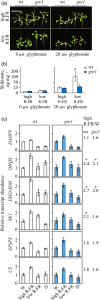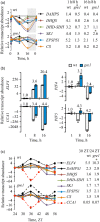A red and far-red light receptor mutation confers resistance to the herbicide glyphosate
- PMID: 24654847
- PMCID: PMC4260087
- DOI: 10.1111/tpj.12513
A red and far-red light receptor mutation confers resistance to the herbicide glyphosate
Abstract
Glyphosate is a widely applied broad-spectrum systemic herbicide that inhibits competitively the penultimate enzyme 5-enolpyruvylshikimate 3-phosphate synthase (EPSPS) from the shikimate pathway, thereby causing deleterious effects. A glyphosate-resistant Arabidopsis mutant (gre1) was isolated and genetic analyses indicated that a dysfunctional red (R) and far-red (FR) light receptor, phytochrome B (phyB), caused this phenotype. This finding is consistent with increased glyphosate sensitivity and glyphosate-induced shikimate accumulation in low R:FR light, and the induction of genes encoding enzymes of the shikimate pathway in high R:FR light. Expression of the shikimate pathway genes exhibited diurnal oscillation and this oscillation was altered in the phyB mutant. Furthermore, transcript analysis suggested that this diurnal oscillation was not only dependent on phyB but was also due to circadian regulatory mechanisms. Our data offer an explanation of the well documented observation that glyphosate treatment at various times throughout the day, with their specific composition of light quality and intensity, results in different efficiencies of the herbicide.
Keywords: Arabidopsis thaliana; circadian rhythm; glyphosate; herbicide resistance; phyB; shikimate pathway.
© 2014 The Authors. The Plant Journal published by Society for Experimental Biology and John Wiley & Sons Ltd.
Figures






Similar articles
-
Improvement of Glyphosate Resistance through Concurrent Mutations in Three Amino Acids of the Pantoea sp. 5-Enolpyruvylshikimate-3-Phosphate Synthase.J Microbiol Biotechnol. 2018 Aug 28;28(8):1384-1390. doi: 10.4014/jmb.1801.01026. J Microbiol Biotechnol. 2018. PMID: 29996624
-
Effects of over-expressing a native gene encoding 5-enolpyruvylshikimate-3-phosphate synthase (EPSPS) on glyphosate resistance in Arabidopsis thaliana.PLoS One. 2017 Apr 20;12(4):e0175820. doi: 10.1371/journal.pone.0175820. eCollection 2017. PLoS One. 2017. PMID: 28426703 Free PMC article.
-
Phytochrome B integrates light and temperature signals in Arabidopsis.Science. 2016 Nov 18;354(6314):897-900. doi: 10.1126/science.aaf5656. Epub 2016 Oct 27. Science. 2016. PMID: 27789798
-
MurA-catalyzed synthesis of 5-enolpyruvylshikimate-3-phosphate confers glyphosate tolerance in bryophytes.Proc Natl Acad Sci U S A. 2024 Nov 19;121(47):e2412997121. doi: 10.1073/pnas.2412997121. Epub 2024 Nov 11. Proc Natl Acad Sci U S A. 2024. PMID: 39527734 Free PMC article.
-
Molecular basis of glyphosate resistance-different approaches through protein engineering.FEBS J. 2011 Aug;278(16):2753-66. doi: 10.1111/j.1742-4658.2011.08214.x. Epub 2011 Jun 28. FEBS J. 2011. PMID: 21668647 Free PMC article. Review.
Cited by
-
Using plant circadian programs to optimize agrochemical use.New Phytol. 2025 Sep;247(6):2557-2563. doi: 10.1111/nph.70346. Epub 2025 Jun 29. New Phytol. 2025. PMID: 40583301 Free PMC article. Review.
-
Plant circadian rhythms regulate the effectiveness of a glyphosate-based herbicide.Nat Commun. 2019 Aug 16;10(1):3704. doi: 10.1038/s41467-019-11709-5. Nat Commun. 2019. PMID: 31420556 Free PMC article.
-
The entry reaction of the plant shikimate pathway is subjected to highly complex metabolite-mediated regulation.Plant Cell. 2021 May 5;33(3):671-696. doi: 10.1093/plcell/koaa042. Plant Cell. 2021. PMID: 33955484 Free PMC article.
-
RNA sequencing-based exploration of the effects of far-red light on lncRNAs involved in the shade-avoidance response of D. officinale.PeerJ. 2021 Feb 12;9:e10769. doi: 10.7717/peerj.10769. eCollection 2021. PeerJ. 2021. PMID: 33614278 Free PMC article.
-
Growth and development of Arabidopsis thaliana under single-wavelength red and blue laser light.Sci Rep. 2016 Sep 23;6:33885. doi: 10.1038/srep33885. Sci Rep. 2016. PMID: 27659906 Free PMC article.
References
-
- Alabadi D, Oyama T, Yanovsky MJ, Harmon FG, Mas P, Kay SA. Reciprocal regulation between TOC1 and LHY/CCA1 within the Arabidopsis circadian clock. Science. 2001;293:880–883. - PubMed
-
- Andel F, 3rd, Lagarias JC, Mathies RA. Resonance raman analysis of chromophore structure in the lumi-R photoproduct of phytochrome. Biochemistry. 1996;35:15997–16008. - PubMed
-
- Benbrook CM. Impacts of genetically engineered crops on pesticide use in the U.S., the first sixteen years. Environ. Sci. Eur. 2012;24:1–13.
MeSH terms
Substances
LinkOut - more resources
Full Text Sources
Other Literature Sources
Molecular Biology Databases

